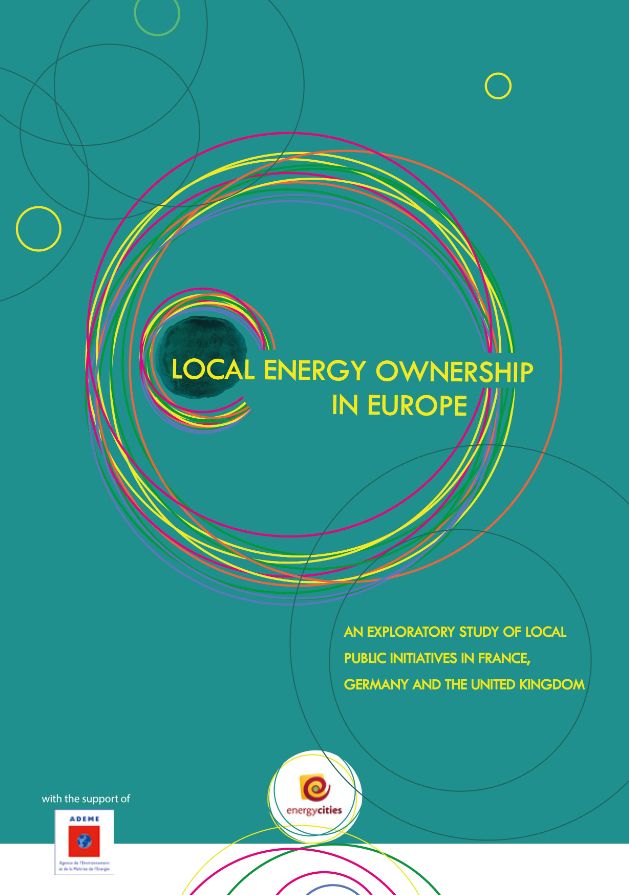Local energy ownership in Europe
An exploratory study of public initiatives in France, Germany and the United Kingdom

“Cities should be at the heart of the energy transition”. This statement from the International Energy Agency’s latest report entitled Energy Technology Perspectives speaks for itself:
with more than half of the global population and about 80% of the world’s GDP, cities account for about two-thirds of primary energy demand and 70% of total energy-related CO2 emissions (IEA, 2016).
But cities are not just major centres of energy consumption, they are also formidable breeding grounds for innovative and ambitious energy transition initiatives.
Politics is certainly the main driving force behind a local public energy ownership initiative, whatever the country in question. Indeed, there are no examples of energy remunicipalisation initiatives or newly established local public companies purely motivated by economic reasons, with no political vision of the added value brought about by reinforcing public energy management, usually associated with an ambitious local energy transition strategy.
A NEW LEASE OF LIFE FOR LE MENÉ, A FRENCH RURAL AREA
With 6,500 inhabitants, the Community of Communes of Le Mené in Brittany is a good example of rural energy transition in France. This association of municipalities was one of the pioneers and founders of the positive energy territory (TEPOS) network. In the early 2000s, the association commissioned a survey of local renewable energy potential (biogas, wind, solar, wood biomass, etc.) which resulted in the publication in 2005 of a strategic plan aimed at reaching 100% renewable energy by 2025. On the initiative of local elected representatives, farmers and citizens, the association successively bought a CHP plant producing biogas from slurry and biowaste (a 15 million euro investment), a vegetable oil fuel plant (rapeseed), a community wind farm (8 million euros), two district heating networks, wood boilers and a number of solar plants and energy-neutral social housing units. To encourage local economic development, the association of communes has also created a business incubator (Menerpôle) as well as an energy business park.
BRISTOL ENERGY: FOR A LOCAL ENERGY TRANSITION
The City of Bristol in England is known for being a breeding ground for local and commu-nity initiatives in favour of an ecological transition, which earned it the title of “European Green Capital” in 2015. Not only has the city council set ambitious energy transition ob-jectives –reducing energy use by 30% and CO2 emissions by 40% between 2005 and 2020- but the first results are extremely encouraging, with a 20% drop in energy use and an 18% decrease in CO2 emissions recorded in 2013 (Bristol, 2015).Inspired by the experience of the German Stadtwerke and with European funding from the ELENA programme, Bristol designed an ambitious strategy to take back control of energy at the city level (Energy Cities, 2015). This strategy led to the setting up of a municipal energy company, Bristol Energy in 2016. The first priority for Bristol Energy is to tackle fuel poverty by delivering fair prices to the population. In the future, the municipal company intends to develop local renewable energy production and energy efficiency services (NEF, 2016). As a complementary approach, Bristol also emphasises the contribution of community energy projects. In 2010, the city helped create the Bristol Energy Network, an organisation supporting community renewable energy initiatives, which in turn developed a local community strategy for energy in 2013 (Bristol Energy Network, 2013). The city then launched a fund to finance renewable community projects, the Bristol Community Energy Fund and took an active part in setting up the Bristol Energy Cooperative, a community cooperative which has already raised 10 million pounds for local projects.
THE FINANCING OF INNOVATIVE ENERGY TRANSITION TOOLS BY THE HANOVER STADTWERKE, ENERCITY
With a turnover of 2.4 billion euros, Hanover’s municipal utility, Enercity, is one of the 10 biggest local public energy suppliers in Germany. Capitalising on its success, Enercity de-veloped the ProKlima fund in 1998 as an innovative tool for financing measures aimed at reducing greenhouse gas emissions.The fund has a 5.5 million euro annual budget financed through a tax included in the city’s gas tariff (1 million euros annually), the allocation of part of Enercity’s profits (3 million euros) and contributions from other participating authorities (Enercity, 2016).
The fund is used to support energy efficiency measures in buildings (renovations and the construction of passive houses) and electricity uses, the development of renewable energy (solar and wind), the connection to heating networks and educational activities related to climate change. In Hamburg, the municipal energy and water management company reports that 536 out of the 850 million euros of added valued generated in 2015 remained within the city area (Hamburg Energie 2016: Geschäftsbericht 2015). For a more detailed description of the ProKlima fund, see (Energy Cities, 2014, p. 33). Between 1998 and 2015, 60 million euros of subsidies were paid out by the fund. The cross-cutting dimension of the measures supported and its innovative financing model ex-plain the fund’s significant leverage: a study has established that each euro of public mo-ney injected as subsidy in 2010 triggered an average of 12.7 euros in investments (Gün-ther, 2011). This means that the 2.6 million euros of subsidies paid out in 2010 generated 33 million euros of investments, creating 47 million euros of added value, of which 42% directly benefited the Hanover area.
